Lonely Fomalhaut turns out to have plenty of company. Learn how to find its two remarkably distant stellar companions.
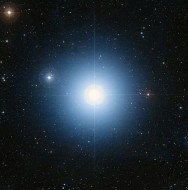
NASA, ESA, DSS 2
Quick! Name the widest double star in the sky. If you chose Alpha Centauri and its faint, distant companion Proxima (separation 2.2°), you would have been correct ... prior to 2013. That year, Eric Mamajek (University of Rochester) and his colleagues announced the discovery of Fomalhaut C, a companion star located a whopping 5.7° northwest of Fomalhaut (Alpha Piscis Austrini) in a different constellation, Aquarius.
Fomalhaut (FO-mal-ought) stands out as the only 1st-magnitude star among the fall constellations. For observers at mid-northern latitudes, it crouches low in the southern sky in the dim constellation Piscis Austrinus, the Southern Fish, and stands due south around 11:00 p.m. local time in early October (10:00 p.m. at mid-month).
Though it may appear isolated in the barren October sky, Fomalhaut has company. It feels the gravitational tug of the magnitude +6.5 star TW Piscis Austrini, 2° to the south. Both are 25 light-years distant and move in tandem across space, partaking of the same proper motion. They form a true double star with an actual separation of 5.5 trillion miles, or 0.91 light-years.
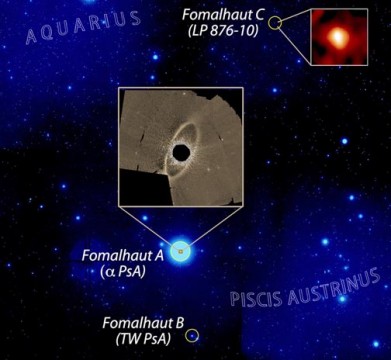
Grant Kennedy (Cambridge), Paul Kalas (UC Berkeley)
Better known as Fomalhaut B, TW PsA is three-quarters as massive as the Sun. The "TW" designation tells us that it's a variable star, and a fascinating one at that. As Fomalhaut B rotates, large starspots cause its light to vary in an irregular fashion. A pair of binoculars and a moonless sky will show it nestled next to 6th-magnitude SAO 214187. Look about 2° south of Fomalhaut to spot it.
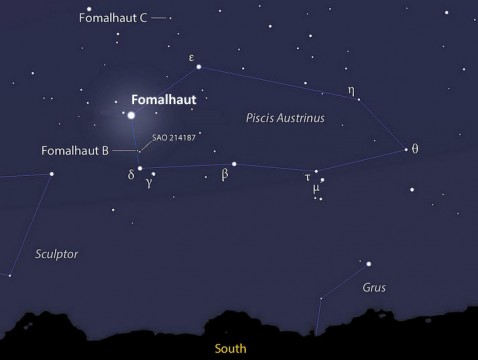
Source: Stellarium
The 2° gap between Fomalhaut A (the main, bright star) and B is nothing to sniff at -- most double stars are much closer. But that's chump change compared to the 11 full moons (5.7°) of sky between Fomalhaut and its newly recognized second companion. When Mamajek and team carefully measured the proper motions and radial velocities (speed toward or away from Earth) of stars in the region, and compared them with precise distance measurements from the Hipparcos satellite, they uncovered yet another member of the Fomalhaut system, an obscure magnitude 12.6 red dwarf we now know as Fomalhaut C.
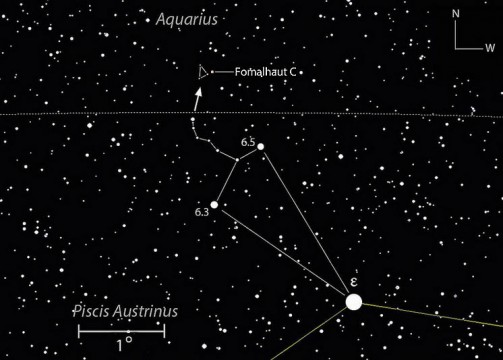
Source: Chris Marriott's SkyMap
A member of one of the widest, if not the widest (known) multiple star system in the sky, Fomalhaut C's true 3D separation is 2.5 light-years from Fomalhaut and 3.2 light-years from Fomalhaut B. While those distances seem impossibly vast, they're well within Fomalhaut's tidal radius of 6.2 light-years, where the star's gravity dominates that of the Milky Way.
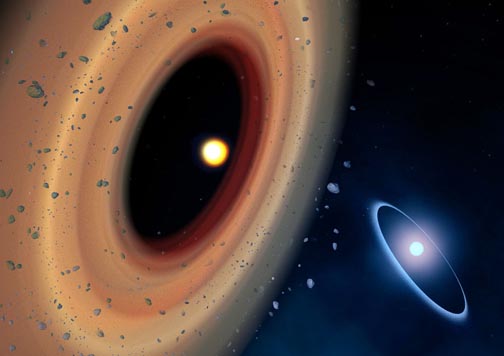
Amanda Smith
When you next look at Fomalhaut twinkling above the fall leaves, put four fingers together and hold them up against the sky. They'll cover about 8°, or the amount of real estate spanned by the triple system. Incredible, isn't it? There are undoubtedly other stars with as wide or wider separations. But Fomalhaut's relative closeness to Earth gives those distances big play in the night sky, helping us appreciate just how prodigious a star's gravitational sphere of influence can truly be.
Need some help navigating the night sky? Check out the Pocket Sky Atlas!
 9
9









Comments
Anthony Barreiro
October 1, 2014 at 1:05 pm
Thanks Bob, this is fascinating!
One quibble: Piscis Austrinus is just one southern fish, so it's singular, not plural like Pisces the fishes. The genitive case would be, for instance, TW Piscis Austrini.
And one request: black on white printable charts work much better for my tired old inkjet printer than white-on-black charts.
You must be logged in to post a comment.
Bob KingPost Author
October 3, 2014 at 9:34 pm
Hi Anthony,
Thanks for pointing out the spelling. Next time I do a chart that goes deep, I'll switch to black on white. Good suggestion.
You must be logged in to post a comment.
Bob-Vangen
October 5, 2014 at 11:10 pm
You can do it yourself with Gimp (free). Screen capture (Prt Sc). Open Gimp and File -> Create -> From Clipboard. Then Colors -> Invert. Then File -> Export ... to save in mp3, png, or whatever.
You must be logged in to post a comment.
Sean Walker
October 2, 2014 at 11:06 am
Thank you Anthony; the spelling errors being addressed.
You must be logged in to post a comment.
Anthony Barreiro
October 2, 2014 at 1:49 pm
One thing I love about astronomy is that it connects us to the whole history of human understanding of the cosmos. I wouldn't know how to form Latin plurals and genitives if not for the relevant star naming conventions.
You must be logged in to post a comment.
Mike
October 2, 2014 at 9:59 pm
Thanks Bob. Reading stories like this reminds me of that old quote about the universe being not only queerer than we suppose, it is queerer than we can suppose! Another fascinating aspect of this far-flung companion that I didn’t see mentioned in this article is its orbital period. In the original paper linked in the article (most of which is waaaaay over my head), they do some rough, back-of-the-envelope level calculations and come up with an orbital period for Fomalhaut C on the order of 20 million years. Truly incredible!
You must be logged in to post a comment.
Bob KingPost Author
October 3, 2014 at 9:34 pm
Cool Mike, thanks for that.
You must be logged in to post a comment.
Peter Wilson
October 3, 2014 at 9:26 am
When a few more companions are found, and they’ll need a new category of astronomical object: the really-really-really-open open-cluster.
You must be logged in to post a comment.
Bob KingPost Author
October 3, 2014 at 9:35 pm
Peter,
Ha - yes!
You must be logged in to post a comment.
You must be logged in to post a comment.